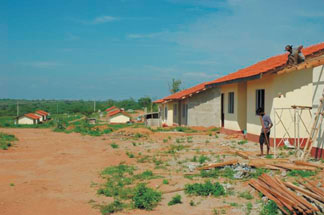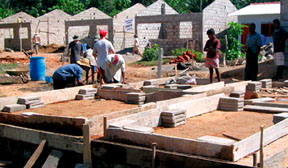|
observer |
|
|
|
|
|
OTHER LINKS |

|

|

|
Wave of changeGalle - On Dec. 26, 2004, a 20-foot - high wave struck more than 600 miles of Sri Lanka's coast, rushing inland for close to 3 miles and wiping out everything in its path. The destruction left behind by the earthquake-triggered tsunami was staggering.
The international community responded to Sri Lanka's plight with more than $2.8 billion pledged by governments, development partnerships, and relief organizations. Officials say more than $2.1 billion of the money has been committed to the recovery effort. But today, almost exactly 18 months later, the path of destruction left by the monster wave is still clearly visible. Travelling from the colonial city of Galle down the west coast to the town of Matara, a visitor is jarred by the contrast between the striking views of aquamarine waters meeting white sand beaches and the skeletal remains of many nearby buildings. "Reconstruction is slow because of aid money mismanagement," said Dr.Rajitha Rubasinghe, a pathologist who worked tirelessly after the disaster, to treat survivors and prevent the spread of disease. ``We hope that with the new government, things will change," he added, referring to the election last November of President Mahinda Rajapaksa . The situation is as complex as the destruction was enormous. Some local residents still cannot stand to even look at the sea, while others cynically call the tsunami "the golden waters" in reference to the profiteering that they allege has occurred . Government bureaucracyThe head of the Red Cross in the Galle area, Upali W. Sirimanne, blames the slow recovery on government bureaucracy . "The housing projects are delayed because the government is not giving land," said Sirimanne. In the Galle area alone, 4,300 people died in the tsunami, while more than 120,000 lost their homes. Sirimanne says, the Red Cross in Galle received more than $1.9 million in aid last year, and the agency has built, or is building, 350 housing units. But the need far outstrips the supply.
While Americans represent a small percentage of those tourists, the number of US visitors increased by 60 per cent - from 15,126 in 2004 to 25,272 in 2005. Michael was optimistic about the continued recovery . The tsunami damaged 53 large and 248 small hotels, and a total of 3,500 guest rooms were lost. "All hotels are back in operation," Michael said, ``except for eight hotels which were totally destroyed." The ongoing conflict between the Sri Lankan government and the Liberation Tigers of Tamil Eelam - known as the Tamil Tigers - has complicated the recovery effort. The escalating violence has resulted in 500 deaths since April, and blocked the distribution of millions in aid dollars that had been allocated for sharing with the rebels in tsunami-impacted areas. Despite the turmoil, the Tourism Ministry estimates that about 250,000 foreign visitors entered the country in the first three months of 2006, an increase of more than 20 per cent during the same period in 2005. Michael was quick to point out that "tourism travel in Sri Lanka is very safe" and that "in the many years of this internal conflict, tourists have never been targeted." Promotional campaignsTo maintain the flow of foreign visitors, the ministry has launched promotional campaigns around the world, particularly in Germany, Britain, France, Japan, and India. They are offering packages through which tourists can buy one airline ticket, and pay for one person at a hotel, and bring a companion for free. "It is very important for tourists to come back, in order for the small businesses to survive," Michael said. In the idyllic cove of Unawatuna, about 10 miles south of Galle, most of the hotels have been rebuilt and are open for business. Tourists are scarce, however. Ravi Liyanage, manager of Surfcity, a guest-house and Internet cafe on the beach, said, the problem is that no one is asking business people what they need. "The government and the international agencies often ignore the resources, needs, and skills of our own local communities," said Liyanage. He points to a fiberglass-boat factory that was built 10 yards from Unawatuna's beautiful beach. A passing breeze carries the acrid smell of the plant's manufacturing processes. Liyanage said the toxic fumes are polluting the area and driving away tourists. Also, he said the factory was built on land where the local school once stood. Now, the 250 students must travel inland, paying bus fares, to get to school. Kavinda, 14, lives in a temporary housing camp outside Galle. He has a shiny new yellow and red bicycle, which his mother bought him with money they received from the government. He rides around on the bicycle, shouting and playing pranks on his schoolmates. Kavinda lost 13 members of his family when the tsunami hit. He and what is left of his family now live in a small, cement block room. While he once was the best student in the area, his mother says, now he cannot pass any of the simplest exams. With reluctance, Kavinda offers an explanation: ``I miss my father. He used to sit every night and help me with homework." Kavinda and the other camp children are gathered together on a blistering hot day by a British relief agency called FunforLife. The group members come to 10 camps in the area to play with the children. The workers believe these traumatized children need to rebuild their confidence through constructive games, while at the same time learning to work together. Emily Burns, one of the FunforLife volunteers, was vacationing in Sri Lanka and survived the tsunami. She decided she had to come back to help the people recover. "The kids are so appreciative," Burns said. "They get so little attention, and they give you so much back. They enjoy even the smallest thing." North of Galle, in a place called Peraliya, there are the remains of a train. The rickety old cars had been travelling south from Colombo, the capital, when they were hit by the monster wave. A total of 1,687 passengers were killed. The wreckage stands battered, all the windows shattered, many of the seats ripped up. It has become a popular stopping point for tourists, since the tsunami. Visitors take pictures, walk inside the ripped up cars, and shudder, imagining the force that wrought this destruction. Outside is a flock of women who surround any passing tourists and offer tales of terrible woe. They lament over children, husbands, and parents who were killed, using the few select English words they have gathered, hanging on to the visitors and pleading for a few rupees. Many Sri Lankans want the train wreckage taken away, while others think it should stand forever as a reminder of the force of nature. Government officials say they want to include the train in a museum that will serve as a monument to the tragedy of the tsunami. "A visitor", said Michael, "will be able to see the gravity of the destruction." Contact Joanna Stavropoulou, a freelance writer in Ethiopia, at [email protected] |
 More than 35,000 people died . Half a million people lost their
homes. More than 11,000 businesses were destroyed, 182 schools damaged,
basic communications, water supplies, and electrical infrastructures
were severely affected. Damage estimates totalled more than $2 billion.
More than 35,000 people died . Half a million people lost their
homes. More than 11,000 businesses were destroyed, 182 schools damaged,
basic communications, water supplies, and electrical infrastructures
were severely affected. Damage estimates totalled more than $2 billion.
 Sri Lankan officials are optimistic, however, that tourists will be
returning in greater numbers despite the slow recovery . According to
the Tourism Ministry, in 2004, Sri Lanka had 566,002 foreign visitors,
while in 2005 the total slipped to 549,308. That is a drop of only 3 per
cent and tourism undersecretary George Michael said that, paradoxically,
the tsunami actually had a somewhat beneficial impact on tourism because
of the international spotlight on Sri Lanka.
Sri Lankan officials are optimistic, however, that tourists will be
returning in greater numbers despite the slow recovery . According to
the Tourism Ministry, in 2004, Sri Lanka had 566,002 foreign visitors,
while in 2005 the total slipped to 549,308. That is a drop of only 3 per
cent and tourism undersecretary George Michael said that, paradoxically,
the tsunami actually had a somewhat beneficial impact on tourism because
of the international spotlight on Sri Lanka. 






